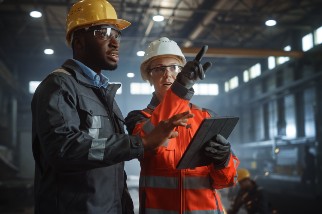This interview has been edited for length and clarity.
Implementing an effective safety and health management system can be challenging for

small to medium-sized businesses. OSHA on-site consultation offers these businesses guidance on how to better protect workers by identifying and addressing hazards.
Todd Schultz, CSP, CHSM, chief administrative officer of the State of Nevada Safety Consultation and Training Section, recently joined
“The Case for Safety Podcast” and spoke with host Scott Fowler to share how OSHA on-site consultation can help small and medium-sized businesses establish and improve safety and health management systems.
Fowler: What is OSHA on-site consultation?
Schultz: This program has been around since 1975. It's free and confidential, and it’s offered in all 50 states and several U.S. territories. It’s primarily for small and medium-sized businesses, and we strive to to help them meet or exceed OSHA standards. The program did more than 20,000 consultation visits across the country in 2022, primarily in manufacturing.
We like to say on-site consultation is often the best kept secret in OSHA, and that's unfortunate because we really feel that the consultation programs across the country are the best programs that that can be offered to small and medium-sized businesses.
Fowler: How does the on-site consultation process work?
Schultz: For an on-site consultation program to come out, the employer has to request a visit. To find your local consultation program, search on OSHA’s website or through the National Association of Occupational Safety and Health Consultation Programs (OSHCON), which lists all the consultation program contacts. Contact your local consultation program, make a request and a consultant will call to schedule a visit with you.
They’ll do a walk-through of the facility, identify potential hazards, look at work practices and areas of interest that the employer wants to examine. The employer has the ability to limit or expand the scope of the visit. If an employer wants a wall-to-wall inspection, consultation can do that. If they just want consultation to look at one operation, they can come in and look at that. Part of a visit will include an assessment of their management system using a safety and health program assessment worksheet, and the consultant will examine each of those elements.
At the end of the visit, consultation will discuss with the employer the list of items found and hazards that were identified during the visit. Consultation will provide recommended program changes and areas for improvement. The agreement made with an employer is that they will correct the items found within a timely manner. There are no fines or penalties.
Fowler: Is there an ongoing partnership between the consultation program and employer after the inspection?
Schultz: The best part of consultation is the partnership and that ongoing relationship, and we strive to develop those relationships and partnerships with these businesses. Building that relationship with the owners, the managers and ultimately the frontline workers. We talk to employees, we want to know what training they've received. Building that trust and having that collaboration with our partners is really critical, and it takes time to build that relationship.
Fowler: Can on-site consultation be customized to an organization’s goals?
Schultz: It is really tailored to every organization's individual needs — if they have certain things they're trying to address or want improve their facility as a whole.
Consultation can come out and assess their concern, research the OSHA standard and look at best practices to help guard or eliminate that hazard to keep employees safe. Last year, the on-site consultation program as a whole identified more than 70,000 serious hazards and removed more than 1.6 million employees from serious hazards. So the impact of on-site consultation is enormous.
Fowler: Can on-site consultation help small businesses develop a safety management system?
Schultz: Absolutely. Often the requests that we get are small employers reaching out when they don't know where to begin. In Nevada, we offer training as well as consultation. We have training classes that we offer online and and in person. We'll go out to their facility and help get their safety program started. We'll see where they are and make recommendations.
We'll walk alongside and ultimately to try to help them succeed in keeping their employees safe and putting a program in place. For a small employer, a safety and help management program or system can be an enormous task. That's where we can come in. We can help them develop safety programs so ultimately their company succeeds.
Fowler: What is the Safety and Health Achievement Recognition Program?
Schultz: The Safety and Health Achievement Recognition Program (SHARP) recognizes small businesses that work with the on-site consultation program and implement effective safety and health programs and management systems.
To achieve SHARP certification, you have to have an injury rate at or below the national average, and you have to score a two or better on all the attributes of a safety and health management assessment. This is an elite group of of employers. It's not easy to achieve, but it's certainly possible if you're willing to put in the time and effort and work with on-site consultation. The benefits are significant.
Fowler: Anything else you’d like to add about OSHA on-site consultation?
Schultz: It's a critical piece of on-site consultation that it's a free resource, it's confidential from enforcement and it can really help employers. Confidentiality is built into
Code of Federal Regulations 1908, and that’s critical to on-site consultation. If that confidentiality between consultation and the employer is breached, the whole program goes goes down in a sense. So we're going to build that trust with them. We're going to build a relationship and a partnership. We're going to let them know their rights and responsibilities as part of the consultation. We're going to work beside them and ultimately try to help them succeed.
Understanding Risk Management and Assessment
We have the resources and expert guidance you need to improve how you assess risks to prevent hazards, protect workers and safeguard equipment.
Learn more